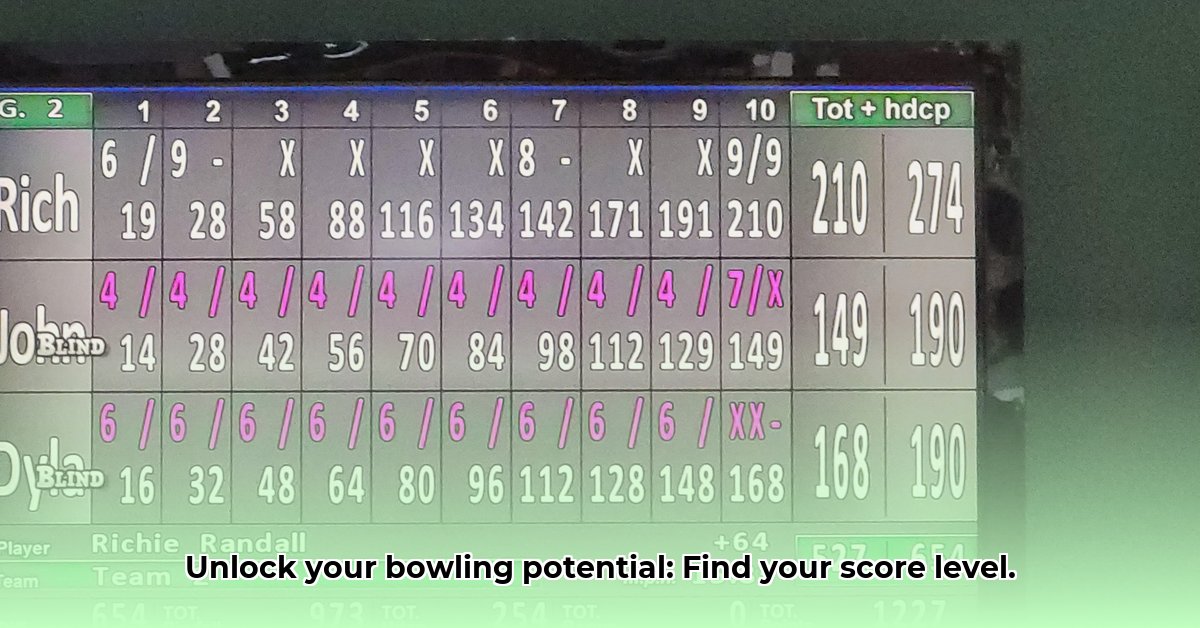Want to know what makes a good bowling score? It’s more nuanced than you might think! What a beginner considers a great score is vastly different from a professional bowler’s expectations. This guide will help you understand what a good score means for your skill level, whether you’re just starting out or aiming for the professional leagues. We’ll explore average scores for beginners, intermediate players, advanced bowlers, and professionals, plus the factors that can affect your score – like the bowling alley itself, your equipment, and even your mental state. We’ll also provide actionable tips and tricks to help you improve your game, so you can bowl better and have more fun doing it! Let’s get rolling!
Understanding Bowling Scores: Mastering the Basics
So, you’re wondering about the benchmark for a good bowling score? That’s a great question, and the answer isn’t as simple as a single number! It’s all relative to your skill level and experience. Think of it like playing a musical instrument – a beginner’s performance sounds quite different from a concert pianist’s. Let’s explore the different stages of your bowling journey, from beginner basics to advanced techniques.
Beginner Bowling: Taking Those First Steps
If you’re just starting out, congratulations! Embrace the learning process and don’t worry about immediately hitting strikes. A good score for a beginner is typically between 50 and 70 pins. Seriously! There’s absolutely no shame in that. The primary focus at this stage is building consistency and getting comfortable with the ball.
- Focus on Form: Develop a smooth, repeatable swing and release. Don’t try to muscle the ball; focus on consistent motion.
- Master the Spare Game: Spares are your best friend! Practice picking up single-pin spares consistently.
- Have Fun! Don’t put too much pressure on yourself. Enjoy the process of learning and improving.
Think of it like learning to ride a bicycle – you might wobble and fall a few times, but eventually, you’ll find your balance. Mastering these fundamentals will pave the way for future success.
Intermediate Bowling: Aiming for Strikes
Once you’ve mastered the basics and can consistently convert spares, it’s time to set your sights on strikes! Intermediate bowlers typically average between 100 and 150 pins. This level is about refining your technique and improving your accuracy.
- Develop a Hook: Learn to impart a controlled hook on the ball. This increases your entry angle into the pocket (the sweet spot between the 1 and 3 pins for right-handers, or the 1 and 2 pins for left-handers), leading to more strikes.
- Understand Lane Conditions: Begin to recognize how lane conditions (oil patterns) affect your ball’s motion. Experiment with different release points and adjustments to your approach.
- Fine-tune Your Release: Pay close attention to your release. A clean, consistent release is essential for accuracy and repeatability.
You’re starting to understand the nuances of ball motion, lane conditions, and your own bowling style. Consistency is paramount here; focus on making each throw count. Small adjustments in your approach and release can lead to significant improvements. Picture yourself climbing a mountain – each strike is like gaining altitude, bringing you closer to the summit!
Advanced Bowling: The Art of Strategy
Advanced bowlers are playing a different game altogether. They’re not just throwing balls; they’re strategizing, reading the lanes, and mastering a wide range of techniques. This group is likely averaging 150 and above.
- Master Multiple Release Styles: Develop the ability to vary your release angle, ball speed, and axis rotation to adapt to different lane conditions.
- Read Lane Conditions Accurately: Learn to identify and interpret subtle changes in lane conditions. Adjust your approach and ball selection accordingly.
- Develop a Spare System: Establish a reliable system for converting difficult spares, including corner pins and splits.
They’ve developed an intuitive understanding of how lane conditions affect their game and use a variety of techniques to overcome these challenges. The right equipment plays a vital role, and they typically have a selection of bowling balls suited for varying lane conditions.
Professional Bowling: Precision and Consistency
Professional bowlers operate at an entirely different level. We’re talking about scores consistently above 200, with some reaching phenomenal scores of 270 and beyond.
- Maximize First Ball Strike Percentage: Aim for a strike percentage of 60% or higher. This requires exceptional accuracy and precise ball placement.
- Maintain High Spare Conversion Percentage: Convert 90% or more of your spare attempts. This is crucial for maximizing your score.
- Manage Pressure Effectively: Develop mental toughness and the ability to perform consistently under pressure.
- Adapt to Varying Lane Conditions and Oil Patterns: Successfully complete the lane and oil pattern to ensure accuracy with each throw.
These athletes are masters of their craft, exhibiting incredible precision and strategic thinking. They’re not only incredibly skilled but also mentally tough, able to maintain focus under intense pressure. For them, bowling is a combination of athleticism, strategy, and an intimate understanding of lane conditions. They analyze their games, practice constantly, and relentlessly seek ways to improve. This is the pinnacle of bowling, where every throw is a calculated move.
Factors That Influence Your Score
Numerous factors can influence your bowling performance. Let’s explore some of the most important ones:
- Lane Conditions: Bowling lanes are far from uniform. Some are oily, some are dry, and there’s everything in between. These conditions affect your ball’s movement, making it crucial to adapt your technique and equipment.
- Ball Selection: The right ball is crucial. Experiment with different weights, cores, surface textures, and layouts to find what works best for your style and the lane conditions.
- Physical Fitness: Bowling requires physical stamina and coordination. Maintaining a good level of fitness will help you maintain consistency and prevent injuries throughout your game.
- Mental Game: Bowling, like many sports, is as much a mental game as it is a physical one. Staying focused, managing pressure, and visualizing success are essential for top performance.
- Approach and Release: A consistent and repeatable approach and release are fundamental to accuracy and consistency.
- Spare Shooting: Converting spares is just as crucial as throwing strikes. Develop a reliable spare system.
- Pin Carry: The arrangement of pins after your first ball can influence how many pins fall. Understanding pin carry and making adjustments can improve your strike percentage.
Tracking Your Progress
To truly improve, you need to track your scores and performance metrics. A simple notebook, a spreadsheet, or even a dedicated bowling app can help you monitor your progress over time.
- Record Your Scores: Keep track of your scores for each game, as well as strikes, spares, open frames, and other relevant statistics.
- Analyze Your Performance: After each game, analyze your performance. What went well? Where did you struggle? Identifying patterns is key to targeted improvement.
- Set Realistic Goals: Set achievable goals for yourself. Focus on improving specific aspects of your game, such as spare conversion percentage or strike percentage.
Setting realistic goals is also crucial. Start with small, attainable goals, and gradually increase your targets as you gain confidence and experience.
Here’s a table summarizing the average score ranges for different skill levels:
| Skill Level | Average Score Range | Key Focus |
|---|---|---|
| Beginner | 50-70 | Fundamentals, spare shooting, having fun! |
| Intermediate | 100-150 | Hook development, lane reading, refining release |
| Advanced | 150-200 | Release variation, precise lane reading, spare system |
| Professional | 200+ | First ball strike %, spare conversion, mental game, consistency |
Remember, bowling is a journey, not a race. Have fun, keep practicing, and don’t get discouraged by occasional low scores. Enjoy the process of improvement, and you’ll see your scores climb steadily. The most important thing is to have a great time while you’re knocking down those pins!
How to Improve Your Bowling Score Based on Your Skill Level
Bowling, like any skill, improves with practice and understanding. The key is to identify your current level and focus on specific areas for improvement. Let’s explore how to boost your game, no matter your current skill set.
Beginner Bowlers: Building a Foundation (0-100 Average)
If you’re just starting out, don’t worry about complex techniques. Focus on the fundamentals.
- Consistent Approach: Develop a smooth, repeatable approach. Pay attention to your footwork and timing.
- Basic Release: Practice a consistent release. Focus on keeping your wrist straight and your hand behind the ball.
- Spare Practice: Dedicate time to practicing spare shooting. Aim at single pins to improve your accuracy.
At this level, consistent, smooth throws are more important than power. Focus on accuracy and repeatability.
Intermediate Bowlers: Developing Your Game (100-150 Average)
You’re hitting spares more consistently – great! Now, let’s work on strikes and adding power.
- Hook Shot Introduction: Learn the basics of throwing a hook. Start with a small hook and gradually increase
- How Did Charles F. Brush Discover Wind Energy Tech? - November 19, 2025
- Wind Energy Vertical: Weighing the Pros and Cons of Wind Power - November 16, 2025
- How Much Energy Does a Wind Turbine Actually Create? - November 14, 2025
















